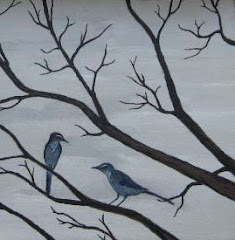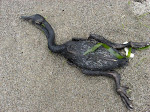Below is my report for last Saturday's Birdathon trip:

On Saturday, May 2nd, “The Murre the Merrier” Birdathon team spent thirteen hours seeking as many species of birds as possible while traveling from Hillsboro to the Coast and back. It rained during much of the day and the species total was smaller than that of the previous year, but the number of "exciting" species was high and everyone had a great time. We began the day at Dawson Creek Park, where we found reliable birds such as Acorn Woodpeckers and Ring-necked Ducks, in addition to Anna’s Hummingbird and Lesser Goldfinch, which had been missed on our previous Birdathons.
After loading into our vehicles, we entered the coast range and stopped at a rest area near the Nehalem River. As we walked along a forest trail, we listened to singing Varied Thrushes and Black-throated Gray Warblers. We “enticed” one of the warblers in for a closer view before moving on to the next stop. After a pause at Klootchy Creek, we arrived in Cannon Beach and marched straight for Haystack Rock.

We quickly spotted Tufted Puffins near their nesting burrows. A small flock of Brown Pelicans passed by and we moved to the other side of the rock in search of Harlequin Ducks.
 Photo by Jill Neson-DeBord
Photo by Jill Neson-DeBordWe saw plenty of Common Murres and Pelagic Cormorants, but no Harlequins, so we prepared to move on to our other stops. As were about to leave, Sarah spotted six ducks at the base of the rock.

They turned out to be five male Harlequins chasing around a single hen! The males were in brilliant breeding plumage and made for the most memorable sighting of the day.
We moved on to the Cannon Beach Settling Ponds where we spent a few minutes spotting ducks and listening to singing Marsh Wrens and Golden-crowned Kinglets. Our next stop was the Nehalem treatment ponds which held flocks of Northern Shovelers and Red-necked Phalaropes swimming in circles to stir up food. As the sun emerged, a Bald Eagle chased a pair of Osprey and a Northern Harrier hunted a field east of the ponds. We ate lunch at Wheeler, then moved on to Tillamook Bay. We pulled off of the road at a cluster of rocks known as the Three Graces.

The rain had resumed, but we found several new birds including Purple Finches, Brandt’s Cormorants, Pigeon Guillemots, Common Loons, and, most surprising of all, a Red-throated Loon in breeding plumage.
We found Black Turnstones and Western Tanagers at the Pacific Oyster Company dock, stopped for coffee in Tillamook, then birded Bayocean Spit. The tide was low and the birds were far from shore, but we were able to find a few Northern Pintails and a single Brant in the bay. We drove uphill to Cape Meares and were greeted by wind gusts that threatened to blow us back down to the bay. Cliff-nesting birds, such as pelagic cormorants hugged the rocks for protection from the wind.
 Photo by Jill Neson-DeBord
Photo by Jill Neson-DeBordAfter a quick walk to the lighthouse, we returned to the parking lot and drove down to Netarts Bay. We picked up Red-breasted Mergansers and an immature Barrow’s Goldeneye as we drove along the bay. At Whalen Island, we located a Brown-Headed Cowbird in its usual spot, but found few other birds, so we drove to Sarah’s parents’ beach house in Pacific City. After some searching, we found an Orange-crowned Warbler behind the house and a Red Crossbill perched on a spruce tree across the street.
As it neared 7:00 pm, we began the drive home. We stopped at the Tillamook River rest area where we found our 100th bird the year before. We added a Brown Creeper to our list and later spotted some Common Mergansers along the Wilson River. At our last stop, we topped off our species list at 86 with a flock of Cliff Swallows east of Banks. Those who finished the trip at Hillsboro said their goodbyes and we look forward to seeing each other again at the Birdathon banquet next month.
Birds seen or heard:
Red-throated Loon
Common Loon
Brown Pelican
Brandt's Cormorant
Double-crested Cormorant
Pelagic Cormorant
Great Blue Heron
Canada Goose
Brant
Wood Duck
Gadwall
American Wigeon
Mallard
Northern Shoveler
Northern Pintail
Green-winged Teal
Ring-necked Duck
Lesser Scaup
Harlequin Duck
Bufflehead
Barrow's Goldeneye
Common Merganser
Red-breasted Merganser
Ruddy Duck
Turkey Vulture
Osprey
Bald Eagle
Northern Harrier
Red-tailed Hawk
American Kestrel
Black Oystercatcher
Western Sandpiper
Red-necked Phalarope
Black Turnstone
Western Gull
Glaucous-winged Gull
Caspian Tern
Common Murre
Pigeon Guillemot
Tufted Puffin
Rock Dove
Band-tailed Pigeon
Mourning Dove
Anna's Hummingbird
Rufous Hummingbird
Belted Kingfisher
Acorn Woodpecker
Northern Flicker
Steller's Jay
Western Scrub Jay
American Crow
Common Raven
Tree Swallow
Violet-green Swallow
Cliff Swallow
Barn Swallow
Black-capped Chickadee
Chestnut-backed Chickadee
Brown Creeper
Bewick's Wren
Winter Wren
Marsh Wren
Golden-crowned Kinglet
American Robin
Varied Thrush
European Starling
Orange-crowned Warbler
Yellow-rumped Warbler
Black-throated Gray Warblers
Wilson's Warbler
Western Tanager
Spotted Towhee
Savannah Sparrow
Song Sparrow
White-crowned Sparrow
Golden-crowned Sparrow
Dark-eyed Junco
Red-winged Blackbird
Brewer's Blackbird
Brown-headed Cowbird
Purple Finch
House Finch
Red Crossbill
Lesser Goldfinch
American Goldfinch
House Sparrow







 Sarah and I took a much-needed break from our respective Spring Busy Seasons this weekend at Pacific City. During the weekend, Sarah's parents hosted their first family get-together at their nearly completed beach house, which has served as the base of beach explorations for several months now. We had some big meals, took some beach walks, and caught up on some reading.
Sarah and I took a much-needed break from our respective Spring Busy Seasons this weekend at Pacific City. During the weekend, Sarah's parents hosted their first family get-together at their nearly completed beach house, which has served as the base of beach explorations for several months now. We had some big meals, took some beach walks, and caught up on some reading.


































